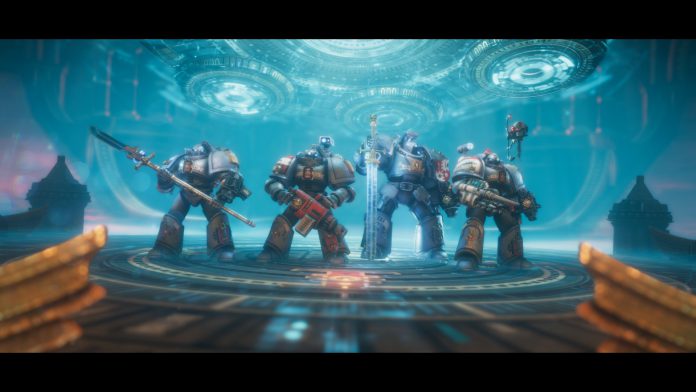If you’ve been following along with Goonhammer’s preview coverage of Complex Games’ Chaos Gate: Daemonhunters, you’d probably pick up on our general positive vibes regarding the game. From our previews we found it to be beautiful, fun to play, and tone-perfect for the general Warhammer 40k aesthetic. Despite this, there were bugs, crashes, and an extremely busy UI. Now that a few of us here at Goonhammer dot com have had a chance to get to grips with the finished product, we feel it’s high time we laid out the definitive review.
Bernhardt: Where to begin with what a breath of fresh air Warhammer 40K: Chaos Gate: Daemonhunters is? Well, not with the title; the current licensing policy with these titles during the resurgence of this brand in the video game space has led to some games with too many names. Just Chaos Gate, please, no one is going to confuse it with the 1998 release. No, the place to begin is the colors. This is a Space Marines game with color! Bright, vibrant color! Neons, argons, heliums, xenons, kryptons — all of the noble gasses are here to play, along with exquisite greens and yellows when appropriate. You wouldn’t expect this from the usual Space Marine video game offerings that have hit shelves recently (relentlessly, they have been red, gold, and black, and mottled green only when orks are involved) but especially not in a game whose main conflict is rendered between the servants of Nurgle and the Grey Knights, whose respective color schemes mostly reflect a range of muted, gross-out greens and the tones of other bodily functions and, well, white and gray.
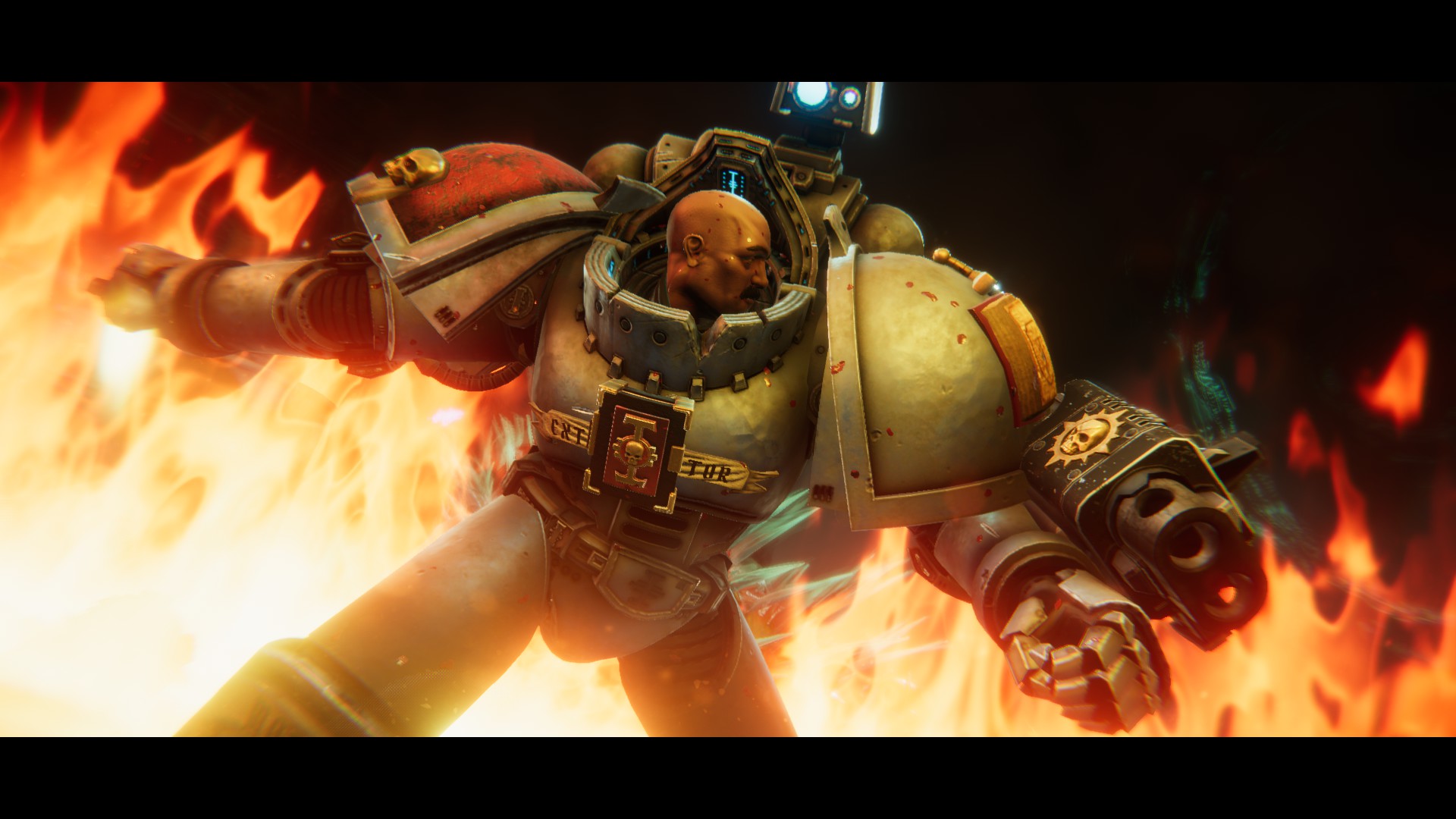
Chaos Gate is instead alive and vibrant in ways that many other entries simply aren’t. It’s full of swooping camera passes and cinematic angles on sumptuously-designed sets inside the game’s home base, the Grey Knight Strike Cruiser Baleful Edict, and chaotic, teeming environments in the wreckage and ruins that constitute the title’s battle maps. Warhammer 40K: Mechanicus is probably the game that suffers the most from a quick aesthetic comparison to Chaos Gate; both games and Warhammer 40K: Battlesector are the three big tactical entries to the franchise recently, and while Battlesector is merely as above — red-armored Space Marines in sand fighting Tyranids whose greens and purples are more subsumed in black-gray chitin than one might want — Mechanicus faces the Adeptus Mechanicus off against the Necrons, and everything is sort of by-the-numbers but with a lot more green wire-framing. Chaos Gate pops. Chaos Gate has a look. The Grey Knights are running around with English words interspersed on their armor with the usual Latin, which honestly makes a much bigger aesthetic difference than you’d suspect just reading that line — but when you throw your first grenade and it slow-mos to focus on WRATH written on the side, you start picking up what the game is putting down.
SRM: The aesthetics of this game are loud in a way that feels extremely Warhammer. Every menu is decked out in Warhammer bric-a-brac in a way Warhammer games simply haven’t bothered with since Dawn of War 1. Much like the modern XCOM games that Chaos Gate so clearly is influenced by, each part of your ship has a character standing around a different part of your base of operations. Naturally, that is the Baleful Edict, a massive Warhammery cathedral spaceship. These characters are recognizably distinct from each other, and while the facial animations on the humans are a little stiff, your Techpriest Dominus clearly had a ton of love put into their animation. Every short cutscene of your ship entering the warp or your dudes teleporting to the surface is delivered with aggressive camerawork and a piñata explosion of particle effects. You can’t skip these, so it’s a good thing they’re so cool to look at.

Piñata explosions are kind of the norm here, as enemies usually explode like you’re using the Bloody Mess perk in Fallout. As their mortal coils are shed, their platelet counts drop to zero and their muscles turn from solid to gas as every Plague Marine and Chaos Cultist rapidly deconstructs into their constituent parts. It’s extremely funny, and the stylized, slightly cartoony visuals bring some levity to what could otherwise come off as pretty gruesome. Those visuals are extremely detailed, with no part of the environment ever falling into the traps of being as generic as “Spaceship Corridor” or “Urban Warzone”. Wherever possible, the terrain resembles the modern GW plastic kits to a grimdark T, with the horizons and skyboxes extending into the impossibly huge cities and starships the 40k setting is known for.
That distinctly 40k pedigree is reinforced by the inclusion of composer Doyle H. Donehoo, who composed the soundtrack to 2008’s Warhammer 40,000: Dawn of War II. The music will sound familiar to anyone who logged a couple hours of DoWII back in the day, with some of the same vocal samples and instrumentation at play. There isn’t anything quite as iconic as that game’s Space Marine theme, but it sounds like 40k should.
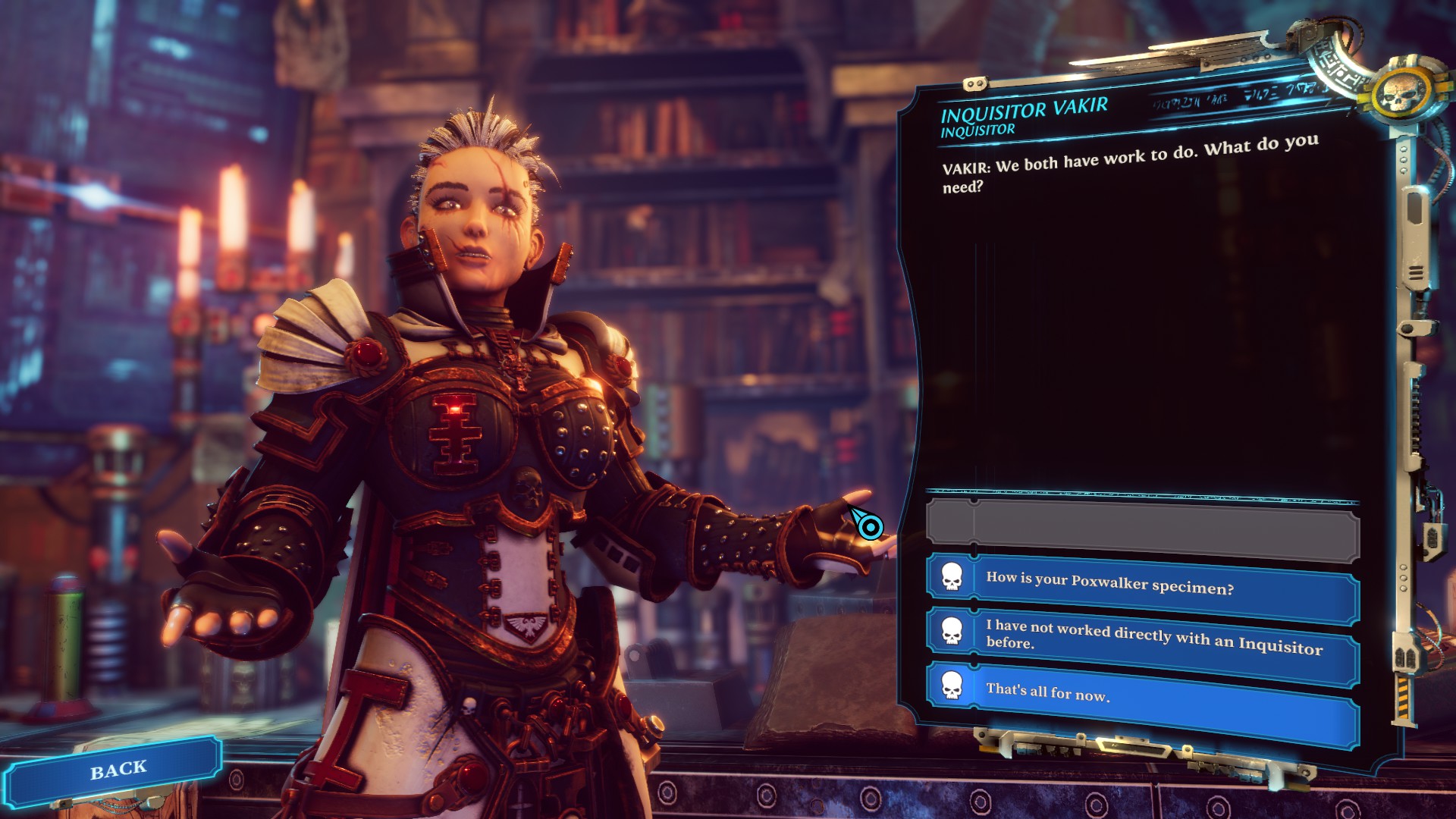
Voice acting is charismatic across the board, with the much-promoted Andy Serkis serving as the Grand Master who gives you performance reviews every so often. Unit barks are the mix of combat information and quotable Warhammerisms you would hope for, and the dialogue in cutscenes is performed well, though it’s sometimes clear that people were recording in different places at different times. The rank and file Nurgle followers sometimes sound a little wooden or like they could have used another take to nail the line, but are good enough. Most of what you hear is the barks of your Grey Knights and their shipmates, and they’re all pretty good company.
The Gameplay
Bernhardt: Veterans of the XCOM reboot franchise put out by Firaxis over the past decade or so will find themselves immediately at home. While Battlesector and Mechanicus admirably tried to distinguish themselves in the small unit tactics space, Chaos Gate is unrepentant about the formula it’s working from. You’ve got a moving home base with a barracks for your persistent, valuable, customizable and individual Space Marines, an engineering lab and research lab (with the proper lore stylings, of course), a mission map with sectors, and missions that generate over time in those sectors while you advance time. Broadly speaking, you’re trying to stop Grandfather Nurgle from plaguing the quadrant, and Nurgle’s plague builds up over time as you let mission timers expire. In the beginning of the game you’ll be forced to choose one mission out of two or three, with the other two generating plague before you can reach them. Once you progress in your research and engineering, you’ll have ways to extend mission timers, get to missions more quickly, and in some cases even reverse the plague. At the end of each arbitrary 45 day period, that’s right, you check in with the Chapter Grandmaster and he rates your performance.
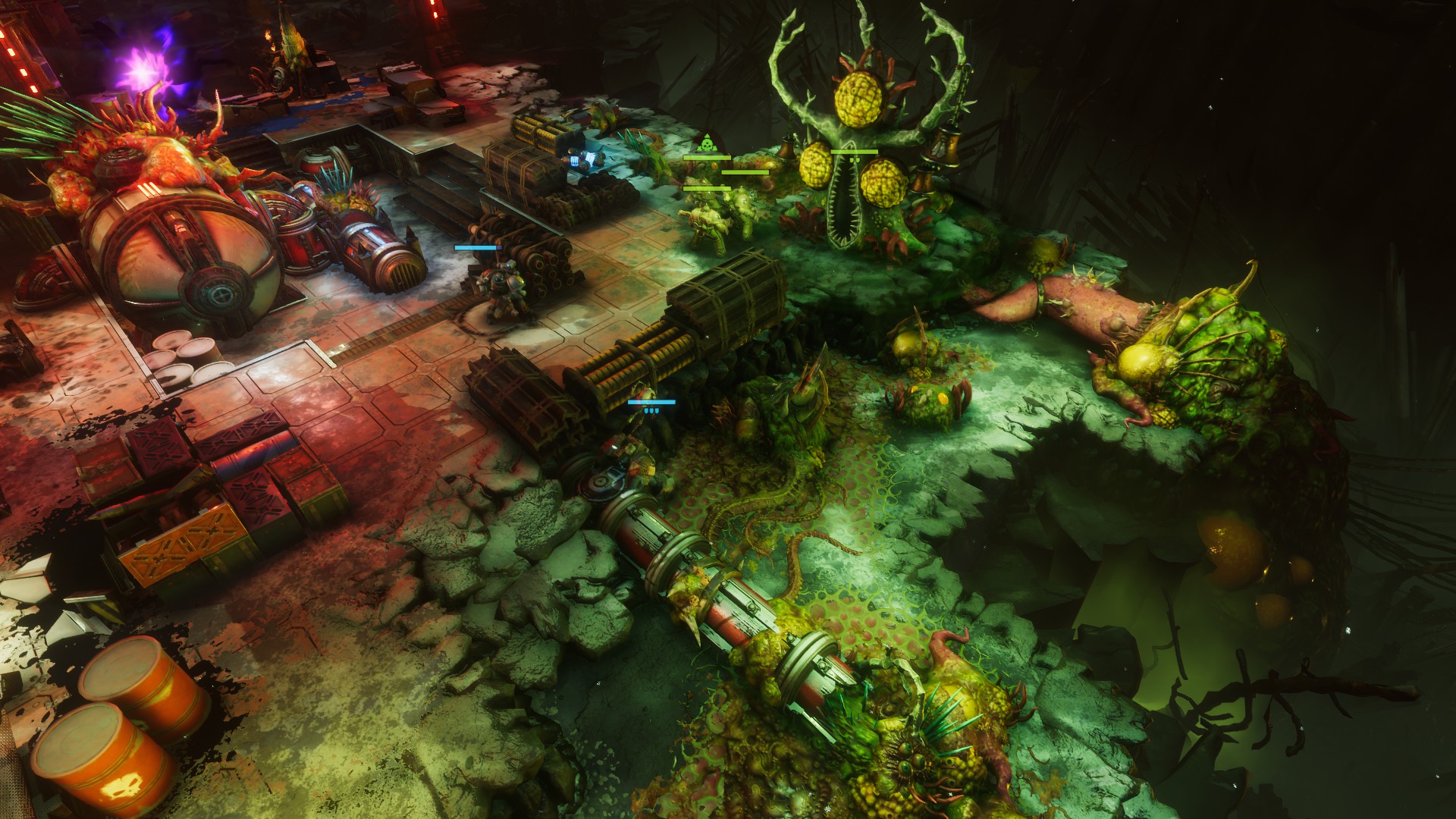
In the moment-to-moment fights, the XCOM formula has been even further improved upon. One of the biggest changes from XCOM 2, which is the real template basis for this game instead of XCOM: Chimera Squad, has to do with enemy discoverability. The biggest issue with XCOM 2, the thing that both kind of made it like a weird sort of chess but mainly in the sense that the midgame was composed of endless positional feints, resets, and re-feints, was initiating contact with the enemy and beginning a fight. You always wanted the enemy to walk into you on their turn, so that they would activate, end their turn, and start yours fresh and in position to kill them — maybe after getting off a few overwatch shots. XCOM 2 gave the player some tools to help tilt this fundamental moment of every mission in the player’s favor, most notably the stealth system that was new to the game following the extremely deterministic activations of XCOM: Enemy Unknown, but in the highest levels of play you were still spending lots of time negotiating very minute positional play that needed a suite of UI mods to simplify and was honestly prone to game bugginess/error even then.
Chaos Gate throws all that out the window. When you activate an enemy pod, they take their activation turn as normal. Every activation in Chaos Gate is what XCOM2 players know as a “yellow alert” activation — rather than being totally surprised, 2-4 members of the enemy pod will take a single AP worth of action after finishing their move, usually to overwatch or self-buff. In exchange, when you activate an enemy pod, your Space Marines completely reset and refresh their AP. Your previous turn just ends with whatever AP you’d left unspent still on the table and everyone gets re-upped, so you’re never stuck wildly out of cover and always have at least some form of the initiative, as Space Marines should. However! If you’re smart and time your activations correctly, you leave less of that AP on the table and have to spend fewer AP in this new turn getting your Marines properly positioned. So the careful positional play from XCOM 2 is still rewarded — but the marginal benefit is much smaller, and the encouragement to play uptempo and with aggression is an excellent change.
SRM: “What if XCOM, but Warhammer” has been the thought on my head since around minute 10 of playing XCOM: Enemy Unknown back in 2012. Buddy, it’s finally here, and it kicks ass. Turn-based tactics games live and die on forcing the player to make difficult decisions, and Daemonhunters is not afraid to make demands of its player. Running across a small group of cultists isn’t going to set anyone’s brain on fire, but when those cultists are layered with roving reinforcements, multiple area of effect abilities, and a growing Chaos Bloom meter, suddenly a straightforward skirmish will turn into a tactical puzzle. While your Grey Knights are extremely capable, they’re always fighting an uphill battle. That push and pull is hard to pull off, and you will be scrabbling for every edge you can get.

There is a critical hit system in place, where enemies can be targeted for specific attacks – lop off an arm to remove their weapon, pierce their armor for extra damage, apply bleeding effects, and so on. You can do these at melee or range, but there’s a bonus melee-only option available if you push their resilience (the little skull icon) down far enough. The enemy falls to their knees, and your melee attack gets what is effectively an automatic crit with the bonus “Execute” command, which will kill them instantly in a Mortal Kombat Fatality-esque special move and give all of your Knights an extra action point. Chaining your attacks just so to get one of these moves off is immensely gratifying, and can turn a fight around. As any player of an action economy game like Necromunda will tell you, extra actions can be extremely powerful.
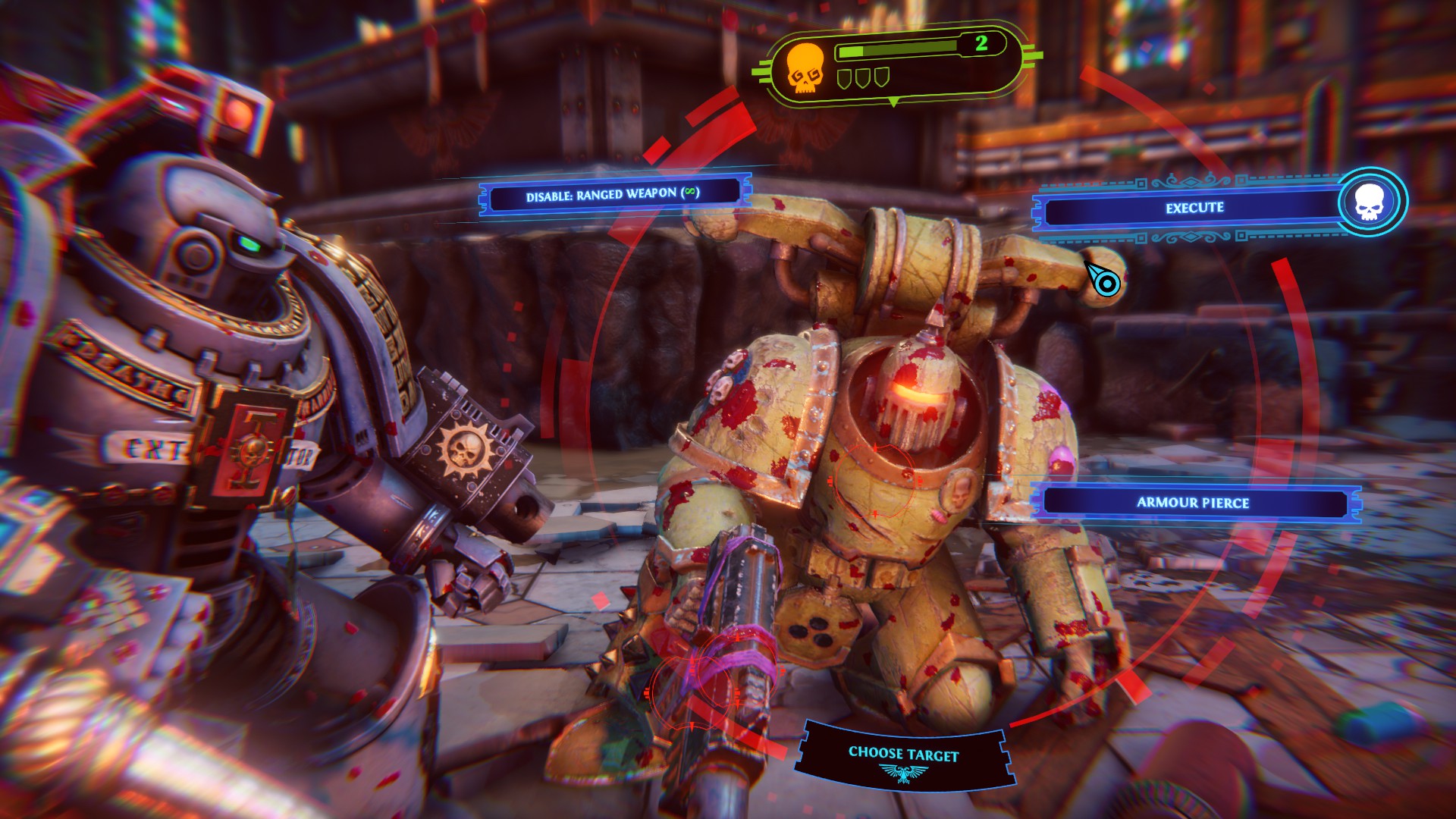
Overwatch is nowhere near as prominent as it is in XCOM, with the area covered being fairly short and narrow. You can’t just huddle in cover, set overwatch traps, and hope for the best, as the Bloom meter will tick up and seriously bad stuff will start to happen. Aggression is the name of the game, because the only thing deadlier than the storm bolter on your Knight’s left wrist is the sword – or thunder hammer! – in their right hand.
Terrain is highly destructible, letting you blow away enemy cover, take out bridges over bottomless pits, or shouldercharge pieces of terrain onto unsuspecting idiots. There’s also explosive hazards all over the map which can be leveraged to destroy surrounding cover, damage enemies, or knock them out of position. In my time playing I never had the enemy take advantage of these against my dudes, but at higher difficulty settings they might be a bit more canny. My favorite parts of terrain interaction are picking up manhole covers and yeeting them as free grenades at the servants of Chaos, and busting down doors. Every time you move a Knight through a doorway it triggers a stupidly cool slo-mo cutscene where they put their boot through it, exposing the room within. I don’t know if this will damage enemies on the opposite side, as they’ve never been standing around, but I’d be sad if it didn’t.
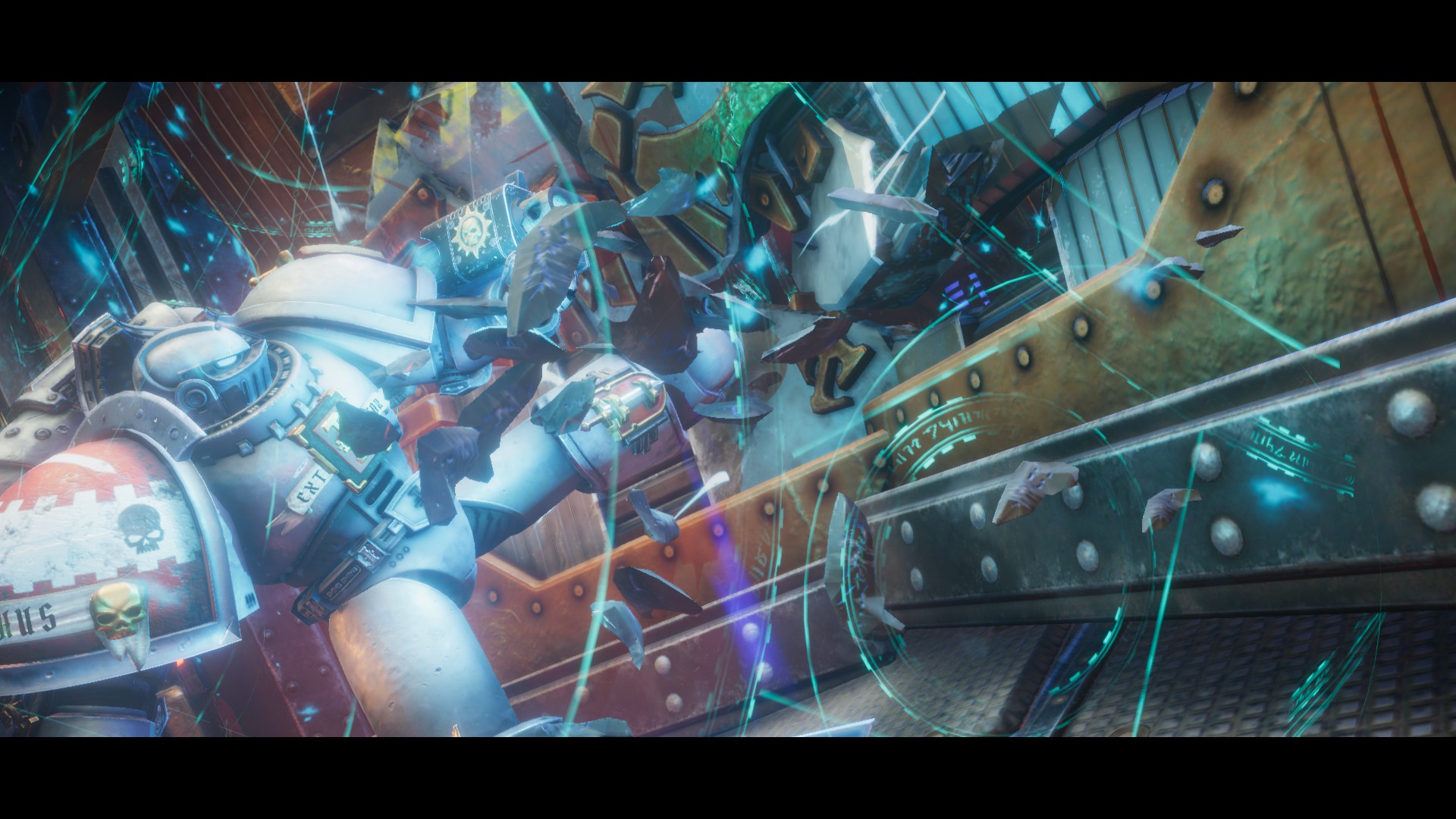
When your Knights go down (and they will go down) they usually have a few turns before they’ll get back up. If you have an Apothecary who can heal them, it’ll get them back up at a reduced maximum HP, but either way they will take a Critical Injury after the mission ends. These lead to them getting bionics (which do nothing initially, but can actually add value once you enhance them), being out of action for a while, and if they suffer enough, dying. Most battles end with most of my dudes needing some R&R before they’re ready to fight again, but at 10 hours I fortunately haven’t had anyone die outside of the tutorial.
Liam: There are a couple of gripes here – particularly at the start of the game, the recovery timer for even light wounds is long, and the key effect of -3 max HP (or -6 for more heavily wounded knights) is pretty punishing at low levels. To some extent the play here is to get a big stable of knights as fast as possible and rotate through them freely, but it’s kind of irritating that there’s so much cool stuff buried in the skill trees when it’s likely that early on you’ll need to swap around between guys quite a lot.
The other main thing is that as SRM points out, you cannot skip any of the animations, either on the star map or in the battles – and even with 30 hours in the game, it will still occasionally play the mini-cutscene explaining to me what Overwatch is when an enemy sets it. I’m sure some of this is just about obfuscating load times, but as awesome as the Baleful Edict leaping into the Warp on its travels is, I’m not sure I need to sit through the full thing every time.
In the scheme of things those are pretty minor, though. The main thing about Chaos Gate is that it’s really fun. The core gameplay is what you’d expect from an Xcom-like, with some tweaks that tend towards giving you more info and reliability to reflect the supersoldier aspect Space Marines bring to the table, but there’s tons of little inclusions where the designers clearly had a choice between being staid and sensible and being awesome, and chose awesome every time. Enemies – at least the smaller, weaker ones – fly around like ragdolls, statues collapse in a wave of destruction annihilating everything they touch, grenades pulp cultists into a fine mist. As things escalate, new types of both Grey Knights and Nurgle-aligned enemies show up, and they are rendered with loving detail and really get the feel right from what you’d expect from the 40k tabletop and lore. The same is true of the maps you play on, which as SRM mentioned have a lot of inclusions obviously drawn from tabletop terrain pieces, as well as additions of the developers’ own to fill the gaps that you wouldn’t normally see on a miniature battlefield. If a game that feels like playing through the best aspects of a Black Library novel sounds like something you’re interested in, then you’ll be well-served here.
The UI
SRM: In our preview coverage, we ran into some issues with the UI conveying too much information all at once. As a result, it was easy to make mistakes or lose track of what was going on. Some of these issues have been put to rest with the final product running in full HD on a native monitor, as opposed to through a lossy stream. Others, however, we can attribute to the game’s learning curve. There’s a lot going on under the hood in Daemonhunters, and while it explains a lot to you, it doesn’t explain everything. For example, it took a few missions to figure out that when you move one of your Knights, faint lines extend from their final position towards all their possible targets. Sometimes these lines don’t show up at all and you just have to make your best guess. The maps are legible enough that there shouldn’t be too many line of sight related surprises here, but it can still bite you in the ass on occasion. Hotkeys are present for various functions of the game now, and mousing over the on-screen buttons will display the associated key – Q and E for camera rotation, Tab for swapping between Knights, and so on. There’s a little inconsistency with the number keys being assigned to their abilities – 1 is always shoot but 2 is not always overwatch – but it’s not too bad.
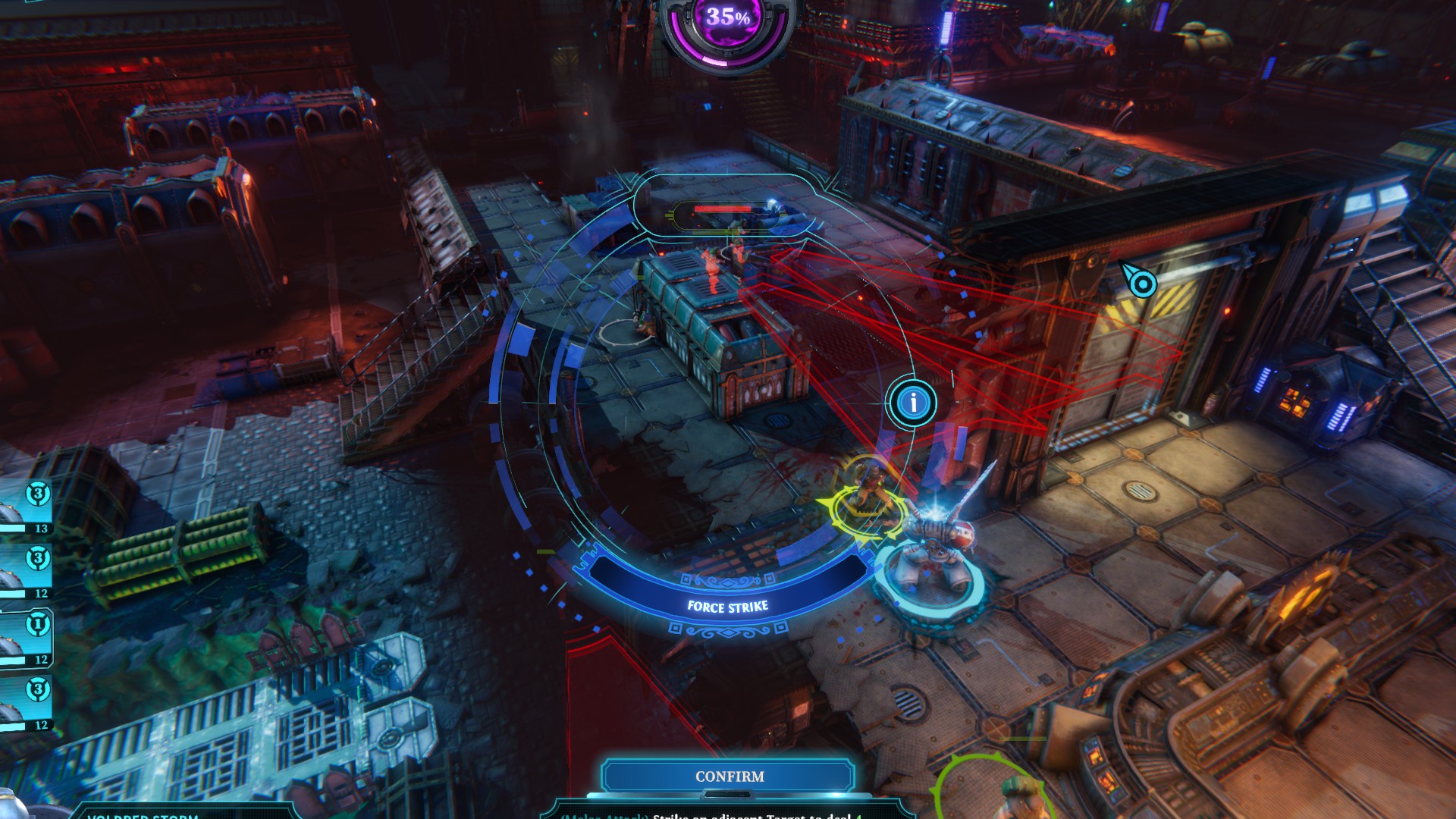
At any given time you can hit little information buttons on your dudes, their dudes, any dudes really, and get a bevy of information about them. This leads to a multiple page character sheet full of stats, buffs, environmental or mutagenic effects, their abilities, all kinds of stuff. Having access to all of this is the developer trying to make things as transparent as possible, always giving the player perfect information if they’re willing to look for it. My guess is that the developers found XCOM’s opacity to be a pain point – a 95% hit chance turning into a miss, a variable damage weapon seemingly always being 1 point short of where you need it to be – and made the game more predictable and legible as a result. I’ll be honest, I’m not sure how much changed between my hands-on demo and the final game, and if the secret is just having more time to mess around when I’m not on a time limit. Regardless, I do think the UI is still rather busy, but it’s because there’s a lot of information to convey and no expense was spared to make it look as Warhammery as humanly possible.
Liam: The UI I think does the job pretty well in most aspects – there’s a lot going on but you mostly have the information you need. It might be nice if there were a little more variety in terms of colour – everything on your side tends to be blue of various degrees of brightness – but otherwise it’s pretty well functional. The one thing that seems like a big miss is the Stratagems button; unlike all the other buttons which are pretty in your face, it’s tucked away at the top right of the screen with your camera controls. The icon is not very distinct, and so it’s easy to forget about entirely. Stratagems themselves are a slightly odd bolt-on. It feels like they might have been added in to give your research something to do, and while they’re perfectly fine – even strong! – there’s plenty of times where you’ll either forget about them or find them locked by the vagaries of the strategy layer, and you don’t really miss them. Their unusual placement seems to reflect this status as an unloved system that’s just sort of there.
Stability
SRM: Stability was the major concern of our hands-on preview, and so far there have been no significant performance issues in the final build. A dropped frame here and there during graphics-intensive moments of environmental destruction is hardly worth writing home about. There’s been a moment where the game hangs on a screen of fire that harkened back to said preview build’s flame-related crashes, but none that lasted long enough to end in a crash. Running at max settings, the game performs admirably.
Liam: In 30 hours I’ve not yet had any kind of stability issue, and I’ve stress tested it pretty heavily with chaining explosions and destroying environments and the like. The only things that come even close are a couple of clunky moments – I had a pathing issue which fired a Purgator into the sky as he tried to descend some stairs, and the animation for the melee auto-attack from Blightlords seems to make everything stop for a second before it snaps back – but those are very much in the realm of oddities rather than being existential.
Final Thoughts:
Bernhardt: I haven’t beaten it yet but Chaos Gate has, you know, a Space Marines story. It’s one of those. The character work is quite good, however, as it will need to be if you’re fundamentally hanging out with three people the entire game. I think I will in fact finish this one, and you’ll only see me again when it’s time to write about the Halo TV show. It’s on Steam for $45 and honestly that seems like a bargain.
SRM: I’ll cut to the quick: this is probably the best 40k game I’ve played since 2011’s Space Marine. Warhammer Fantasy has had some great games with Total War and Vermintide, but most 40k games haven’t quite hit those highs in a long time. I was hoping to beat Daemonhunters in time for the final review, but at roughly 10 hours I feel like there’s still so much more to see and do. I’ve only scratched the surface of the techtrees, requisition options, weapons and classes, and the story is still shrouded in mystery. I do wonder just how involved Aaron Dembski-Bowden was in the writing process, but there are some appealing characters and story moments that feel like they’d be at home in one of his books. I would say at 45 bucks or local equivalent, this is a real damn good buy from a developer I’m going to keep my eye on from here on out, and I hope they can build on this in the future. The potential here is almost as huge as the 40k setting itself, and I hope Complex Games can keep making games this good for a long time to come.
Liam: I’ve played a frankly unreasonable amount of it already, and I don’t intend to stop. I will never tire of blasting Plague Marines into the abyss with a well-placed krak grenade, or of putting a thunder hammer through a Blightlord’s face. The risk with this game was obvious – is it going to be the kind of licensed 40k game that adds a thin veneer of Warhammer stuff onto a boring copy of a well-proven formula? The answer is no – it layers a thick veneer of Warhammer stuff onto a really entertaining copy of a well-proven formula, with the changes to that formula largely enhancing, rather than detracting from, the experience. My immediate thought on playing this was how well this format would work for all kinds of 40k factions. Deathwatch seem like an obvious use-case for the same formula, but how great would a version of this be that let you command a squad of different Aspect Warriors, or where you could play the Chaos side – maybe a Black Legion force letting you draw on the different Cult troops? The fact that I’m thinking like this, unlike e.g. Battlesector which was fine but where I was very, very ready to be done with it by the end, despite it featuring one of my two favourite Chapters, should tell you how much I’m enjoying Chaos Gate.
Have any questions or feedback? Drop us a note in the comments below or email us at contact@goonhammer.com.
